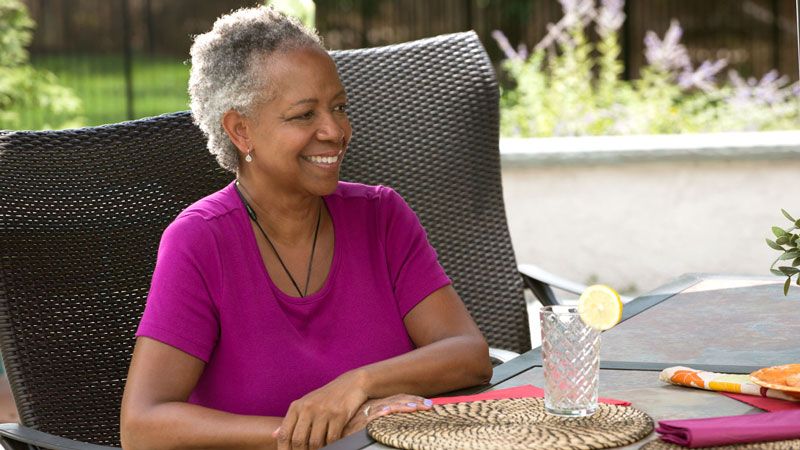When it’s hot outside, older adults need to take special precautions to stay cool and avoid overheating. As we age, our bodies can’t deal with the heat as well as when we were younger. This can be due to lower sweat levels, medications that cause heat intolerance, and a lowered ability to adjust to fast changes in temperature. Read on for tips to stay cool when it’s hot out, as well as signs of heat exhaustion and heat stroke.
Staying Cool Inside
While air conditioning goes a long way toward helping people stay cool in the hot summer months, it can be expensive to run when the temperatures soar. And if you use window units rather than central air, part of your house likely stays toasty all day long.
Here are some ways to stay cool in and around your house.
- Close drapes and blinds during the day, especially on east, south, and west-facing windows.
- Dress in lightweight, thin clothing that breathes, such as cotton or linen.
- Drink water about every 30 minutes, not waiting until you feel thirsty to get a drink. This is important even when you’re inside. If you take diuretics (water pills) or your doctor has put you on a fluid restriction, ask them how much water you should drink each day.
- Avoid drinking alcohol, sugary drinks, and caffeine, which can raise the risk of dehydration.
- Avoid using your stove or oven for cooking. Instead, choose foods like fruit, salads, and sandwiches that don’t need to be heated up.
- Stay cool by using a damp washcloth on your head and neck or taking a cool shower or bath.
- Take advantage of air-conditioned public places such as senior centers, libraries, recreation centers, and coffee shops. This is especially important if your house is not air-conditioned.
- If your house has more than one story, spend as much time as possible on the lowest floor, where it’s the coolest.
The Centers for Disease Control and Prevention warns that electric fans should be used only when it’s below 90 degrees outside. Using a fan at higher temperatures can mask the signs of heat exhaustion by blowing warm air on you, causing more sweating but making you feel cool (even when you’re not).
When you’re in the house, use home alert systems for seniors, such as Medical Guardian’s MGHome Cellular, in case of an emergency.
Keeping Cool Outside
It’s not as easy to stay comfortable outside when it’s hot, but there are measures you can take to avoid overheating.
- Wear light colors and thin, loose-fitting, breathable fabrics to allow body heat to escape.
- Take a break often to sit in the shade and cool down — in a breezy spot if possible.
- When working or exercising outdoors, try to get everything done in the early morning hours when it’s the coolest. The late evening can be a good time too, but on the hottest days, it may not cool down enough to be safe even after the sun
goes down. - Always have cool water with you, and be sure to take a drink at least every 20 minutes, even if you don’t feel thirsty.
- Wear sunscreen and a large hat to prevent sunburn.
Any time you’re outside, especially in the heat, use a personal medical alert device with GPS, such as Medical Guardian’s MGMini, to stay safe on the go.
Symptoms of Overheating
Getting too hot can cause heat exhaustion, which may progress to heat stroke if left untreated. Both conditions are especially dangerous for older adults. Read on for signs of heat exhaustion and heat stroke, so you know when to seek help.
Heat Exhaustion
Heat exhaustion happens when we overheat and our bodies can’t cool down. It is the body’s response to a loss of water and salt, usually because of sweating or physical activity in hot weather. Heat exhaustion oftens affects the edlderly and people with high blood press.
- Muscle cramps
- Nausea (sometimes with vomiting)
- Headache
- Dizziness
- Weakness and fatigue
- Cold, clammy, pale skin
- Fast, shallow pulse and breathing
- Fainting
Heat Stroke
more serious heat-related illness is heat stroke. It happens when our bodies are no longer able to control its temperatue. Our temperature rises rapidly and we are not able to cool ourselves by sweating. When this occurs, the body temperature can skyrocket, sometimes reaching 106°F or higher very quickly.
- Body temperature of 104 degrees Fahrenheit or higher
- Red, hot skin
- Fast, strong pulse
- Confusion
- Dizziness
- Nausea
- Loss of consciousness
Treatments for heat exhaustion and heat stroke are complex in older adults. Along with cooling the overheated person down, fluids and electrolytes need to be replaced carefully to avoid problems that can be caused by electrolyte imbalances.
That’s why it’s so important for older adults to have a medical alert system, both in the house and outside. If you start to notice any of the symptoms above, call a friend or family member or use your Medical Guardian medical alert system to call the monitoring center. The representative will talk to you and determine what type of help you need.

